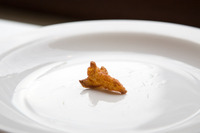 Researchers from Cornell University have been exploring a new angle on food printing: the use of hydrocolloids. What the heck is that? From their paper:
Researchers from Cornell University have been exploring a new angle on food printing: the use of hydrocolloids. What the heck is that? From their paper:Using a novel combination of hydrocolloids (xanthium gum and gelatin) and flavor agents, texture and flavor can be independently tuned to produce printing materials that simulate a broad range of foods, with only a minimal number of materials.
In other words, produce many different foods from a limited set of edible materials.
This problem can be observed in the design of MIT’s concept Cornucopia device, which requires as many as twelve different food material canisters – and perhaps even more on the shelf. One can imagine a future 3D kitchen with racks of these canisters. That’s likely impractical and besot with logistical difficulties. The new approach tries to circumvent this issue.
Some of the hydrocolloid techniques sound very interesting (not to mention tasty):
The result is “culinary magic” including “flavored gelatin spheres with liquid centers, sauce foams, hot liquid deserts with flash frozen shells, syringe-extrudable meats, and much more.” They describe several incredible uses of the technology, including messages inside cakes (seen above) or “prime rib with a hidden message”.
We’ve had prime rib like that, but not quite the same thing…
Via Cornell (Hat tip to Jeffrey)

